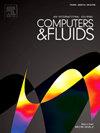Modal and nonmodal global instabilities of rotating incompressible axisymmetric boundary layer
IF 2.5
3区 工程技术
Q3 COMPUTER SCIENCE, INTERDISCIPLINARY APPLICATIONS
引用次数: 0
Abstract
This study discusses the modal and non-modal global instabilities of the boundary layer produced on a rotating circular cylinder. An investigation was conducted on a flow of in-compressible fluid over a rotating cylinder of fixed length. The rotation effect of a cylinder generates pressure gradient and centrifugal force radially. The Reynolds number (Re) and rotation rate (S) were calculated using the cylinder’s radius. The Spectral collocation approach discretizes the 3D stability equations in cylindrical polar coordinates, resulting in an initial value problem. Computations were performed for azimuthal wave numbers, N = 0, 1, 2, and 3, Re = 2600, 5200, and 20800, and S = 0.0, 0.5, 1.0, and 2.0. The transient energy growth () and optimal disturbances were computed by appropriately superimposing the global modes. The perturbation structure that maximizes has been analyzed. The S enhances the optimal value of for a specific Re and N. The highest was observed for helical mode at low Re and for axisymmetric mode at higher Re. The disturbances’ spatial structure has been elongated in the shear direction and has grown and intensity as and have increased. The perturbation structures are qualitatively distinct for and . The energy budget components have been notably impacted by the alterations in the base-flow caused by the influence of .
旋转不可压缩轴对称边界层的模态和非模态全局不稳定性
本研究讨论了旋转圆筒上产生的边界层的模态和非模态全局不稳定性。研究对象是固定长度的旋转圆柱体上的不可压缩流体流。圆柱体的旋转效应在径向产生压力梯度和离心力。利用圆柱体的半径计算了雷诺数(Re)和旋转率(S)。光谱配位法将三维稳定方程离散到圆柱极坐标中,从而产生一个初值问题。计算的方位角波数为 N = 0、1、2 和 3,Re = 2600、5200 和 20800,S = 0.0、0.5、1.0 和 2.0。通过适当叠加全局模式,计算出瞬态能量增长(G(t))和最佳扰动。分析了最大化 G(t) 的扰动结构。在低 Re 条件下,螺旋模式 N=1 的 G(t) 最大,而在高 Re 条件下,轴对称模式 N=0 的 G(t) 最大。扰动的空间结构在剪切方向上被拉长,并随着 S 和 Re 的增大而增强。扰动结构在 N=0 和 N=1 时有本质区别。由于 S 的影响,基流发生了变化,能量收支成分受到了明显的影响。
本文章由计算机程序翻译,如有差异,请以英文原文为准。
求助全文
约1分钟内获得全文
求助全文
来源期刊

Computers & Fluids
物理-计算机:跨学科应用
CiteScore
5.30
自引率
7.10%
发文量
242
审稿时长
10.8 months
期刊介绍:
Computers & Fluids is multidisciplinary. The term ''fluid'' is interpreted in the broadest sense. Hydro- and aerodynamics, high-speed and physical gas dynamics, turbulence and flow stability, multiphase flow, rheology, tribology and fluid-structure interaction are all of interest, provided that computer technique plays a significant role in the associated studies or design methodology.
 求助内容:
求助内容: 应助结果提醒方式:
应助结果提醒方式:


